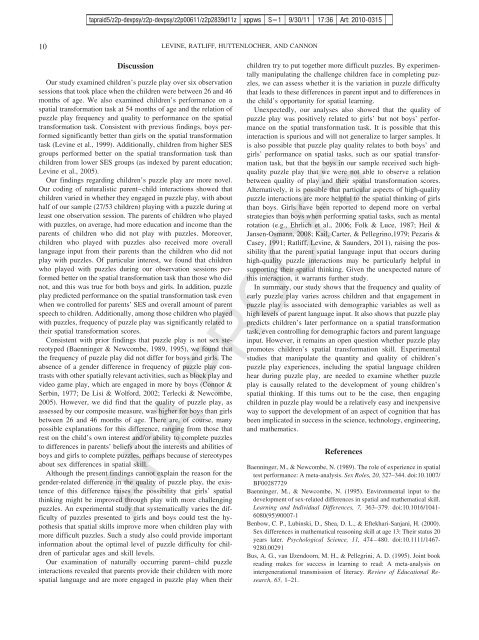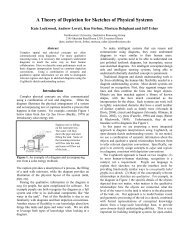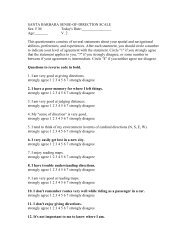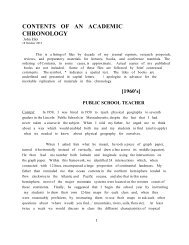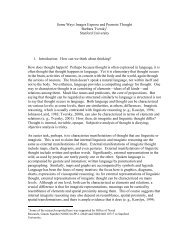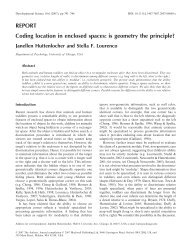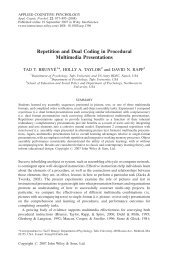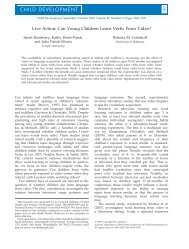Early Puzzle Play: A Predictor of Preschoolers' Spatial ...
Early Puzzle Play: A Predictor of Preschoolers' Spatial ...
Early Puzzle Play: A Predictor of Preschoolers' Spatial ...
Create successful ePaper yourself
Turn your PDF publications into a flip-book with our unique Google optimized e-Paper software.
tapraid5/z2p-devpsy/z2p-devpsy/z2p00611/z2p2839d11z xppws S1 9/30/11 17:36 Art: 2010-0315<br />
10 LEVINE, RATLIFF, HUTTENLOCHER, AND CANNON<br />
Discussion<br />
Our study examined children’s puzzle play over six observation<br />
sessions that took place when the children were between 26 and 46<br />
months <strong>of</strong> age. We also examined children’s performance on a<br />
spatial transformation task at 54 months <strong>of</strong> age and the relation <strong>of</strong><br />
puzzle play frequency and quality to performance on the spatial<br />
transformation task. Consistent with previous findings, boys performed<br />
significantly better than girls on the spatial transformation<br />
task (Levine et al., 1999). Additionally, children from higher SES<br />
groups performed better on the spatial transformation task than<br />
children from lower SES groups (as indexed by parent education;<br />
Levine et al., 2005).<br />
Our findings regarding children’s puzzle play are more novel.<br />
Our coding <strong>of</strong> naturalistic parent–child interactions showed that<br />
children varied in whether they engaged in puzzle play, with about<br />
half <strong>of</strong> our sample (27/53 children) playing with a puzzle during at<br />
least one observation session. The parents <strong>of</strong> children who played<br />
with puzzles, on average, had more education and income than the<br />
parents <strong>of</strong> children who did not play with puzzles. Moreover,<br />
children who played with puzzles also received more overall<br />
language input from their parents than the children who did not<br />
play with puzzles. Of particular interest, we found that children<br />
who played with puzzles during our observation sessions performed<br />
better on the spatial transformation task than those who did<br />
not, and this was true for both boys and girls. In addition, puzzle<br />
play predicted performance on the spatial transformation task even<br />
when we controlled for parents’ SES and overall amount <strong>of</strong> parent<br />
speech to children. Additionally, among those children who played<br />
with puzzles, frequency <strong>of</strong> puzzle play was significantly related to<br />
their spatial transformation scores.<br />
Consistent with prior findings that puzzle play is not sex stereotyped<br />
(Baenninger & Newcombe, 1989, 1995), we found that<br />
the frequency <strong>of</strong> puzzle play did not differ for boys and girls. The<br />
absence <strong>of</strong> a gender difference in frequency <strong>of</strong> puzzle play contrasts<br />
with other spatially relevant activities, such as block play and<br />
video game play, which are engaged in more by boys (Connor &<br />
Serbin, 1977; De Lisi & Wolford, 2002; Terlecki & Newcombe,<br />
2005). However, we did find that the quality <strong>of</strong> puzzle play, as<br />
assessed by our composite measure, was higher for boys than girls<br />
between 26 and 46 months <strong>of</strong> age. There are, <strong>of</strong> course, many<br />
possible explanations for this difference, ranging from those that<br />
rest on the child’s own interest and/or ability to complete puzzles<br />
to differences in parents’ beliefs about the interests and abilities <strong>of</strong><br />
boys and girls to complete puzzles, perhaps because <strong>of</strong> stereotypes<br />
about sex differences in spatial skill.<br />
Although the present findings cannot explain the reason for the<br />
gender-related difference in the quality <strong>of</strong> puzzle play, the existence<br />
<strong>of</strong> this difference raises the possibility that girls’ spatial<br />
thinking might be improved through play with more challenging<br />
puzzles. An experimental study that systematically varies the difficulty<br />
<strong>of</strong> puzzles presented to girls and boys could test the hypothesis<br />
that spatial skills improve more when children play with<br />
more difficult puzzles. Such a study also could provide important<br />
information about the optimal level <strong>of</strong> puzzle difficulty for children<br />
<strong>of</strong> particular ages and skill levels.<br />
Our examination <strong>of</strong> naturally occurring parent–child puzzle<br />
interactions revealed that parents provide their children with more<br />
spatial language and are more engaged in puzzle play when their<br />
children try to put together more difficult puzzles. By experimentally<br />
manipulating the challenge children face in completing puzzles,<br />
we can assess whether it is the variation in puzzle difficulty<br />
that leads to these differences in parent input and to differences in<br />
the child’s opportunity for spatial learning.<br />
Unexpectedly, our analyses also showed that the quality <strong>of</strong><br />
puzzle play was positively related to girls’ but not boys’ performance<br />
on the spatial transformation task. It is possible that this<br />
interaction is spurious and will not generalize to larger samples. It<br />
is also possible that puzzle play quality relates to both boys’ and<br />
girls’ performance on spatial tasks, such as our spatial transformation<br />
task, but that the boys in our sample received such highquality<br />
puzzle play that we were not able to observe a relation<br />
between quality <strong>of</strong> play and their spatial transformation scores.<br />
Alternatively, it is possible that particular aspects <strong>of</strong> high-quality<br />
puzzle interactions are more helpful to the spatial thinking <strong>of</strong> girls<br />
than boys. Girls have been reported to depend more on verbal<br />
strategies than boys when performing spatial tasks, such as mental<br />
rotation (e.g., Ehrlich et al., 2006; Folk & Luce, 1987; Heil &<br />
Jansen-Osmann, 2008; Kail, Carter, & Pellegrino,1979; Pezaris &<br />
Casey, 1991; Ratliff, Levine, & Saunders, 2011), raising the possibility<br />
that the parent spatial language input that occurs during<br />
high-quality puzzle interactions may be particularly helpful in<br />
supporting their spatial thinking. Given the unexpected nature <strong>of</strong><br />
this interaction, it warrants further study.<br />
In summary, our study shows that the frequency and quality <strong>of</strong><br />
early puzzle play varies across children and that engagement in<br />
puzzle play is associated with demographic variables as well as<br />
high levels <strong>of</strong> parent language input. It also shows that puzzle play<br />
predicts children’s later performance on a spatial transformation<br />
task, even controlling for demographic factors and parent language<br />
input. However, it remains an open question whether puzzle play<br />
promotes children’s spatial transformation skill. Experimental<br />
studies that manipulate the quantity and quality <strong>of</strong> children’s<br />
puzzle play experiences, including the spatial language children<br />
hear during puzzle play, are needed to examine whether puzzle<br />
play is causally related to the development <strong>of</strong> young children’s<br />
spatial thinking. If this turns out to be the case, then engaging<br />
children in puzzle play would be a relatively easy and inexpensive<br />
way to support the development <strong>of</strong> an aspect <strong>of</strong> cognition that has<br />
been implicated in success in the science, technology, engineering,<br />
and mathematics.<br />
References<br />
Baenninger, M., & Newcombe, N. (1989). The role <strong>of</strong> experience in spatial<br />
test performance: A meta-analysis. Sex Roles, 20, 327–344. doi:10.1007/<br />
BF00287729<br />
Baenninger, M., & Newcombe, N. (1995). Environmental input to the<br />
development <strong>of</strong> sex-related differences in spatial and mathematical skill.<br />
Learning and Individual Differences, 7, 363–379. doi:10.1016/1041-<br />
6080(95)90007-1<br />
Benbow, C. P., Lubinski, D., Shea, D. L., & Eftekhari-Sanjani, H. (2000).<br />
Sex differences in mathematical reasoning skill at age 13: Their status 20<br />
years later. Psychological Science, 11, 474–480. doi:10.1111/1467-<br />
9280.00291<br />
Bus, A. G., van IJzendoorn, M. H., & Pellegrini, A. D. (1995). Joint book<br />
reading makes for success in learning to read: A meta-analysis on<br />
intergenerational transmission <strong>of</strong> literacy. Review <strong>of</strong> Educational Research,<br />
65, 1–21.


